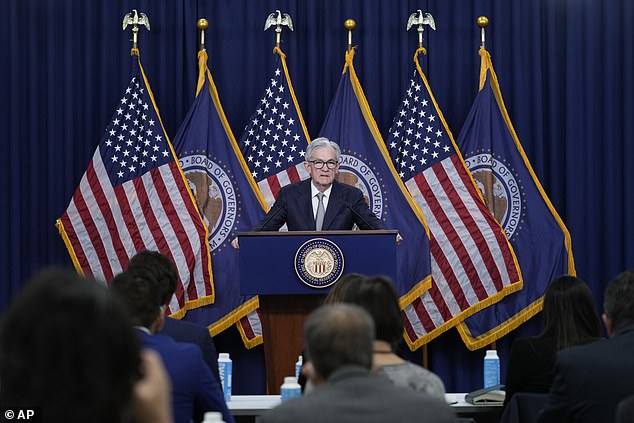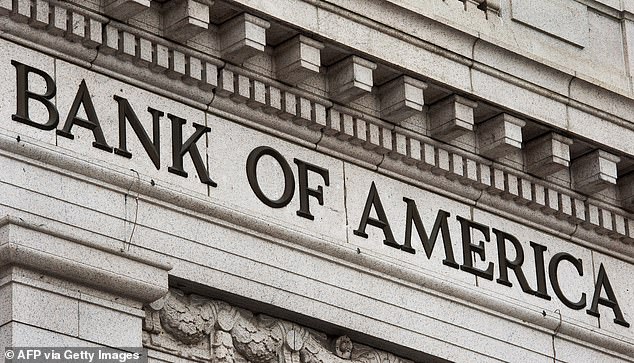Interest rate cuts are coming next year, Bank of America says, as bank predicts 2024 will be ‘year of the landing’ for the economy – what does it mean for you?
Bank of America has predicted that the Federal Reserve will finally start cutting interest rates from the middle of next year, and that benchmark borrowing costs will fall below 5 percent by 2024.
In an effort to curb inflation, the Fed began an aggressive rate hike campaign in March 2022, pushing rates to their current 22-year high of between 5.25 and 5.5 percent.
If interest rates do indeed go down, it would lead to a reduction in credit card and mortgage rates, among other borrowing costs, experts say.
Instead of a recession, as many economists expected this year, the bank expects inflation to slowly fall in what is now being called a “soft landing.”
“2023 defied almost everyone’s expectations: recessions that never happened, rate cuts that didn’t materialize,” said Candace Browning, head of BofA Global Research. “We expect that 2024 will be the year in which central banks can successfully organize a soft landing.”
The Bank of America has predicted that the Federal Reserve will finally cut interest rates from the middle of next year
Michael Gapen, head of US economics at the bank, predicted that when inflation finally begins to cool, the Federal Reserve will respond by cutting rates.
In October, annual inflation fell to 3.2 percent, down from 3.7 percent in September.
Gapen “expects the first Fed rate cut to occur in June and the central bank to cut by 25 basis points per quarter through 2024,” the bank said.
He therefore predicts interest rates of around 5 to 5.25 percent in June 2024. Two more declines over the next two quarters would leave interest rates at between 4.5 and 4.75 percent at the end of next year.
However, forecasts for next year vary, with other indicators predicting a bigger drop in interest rates.
According to the CME FedWatch toolThe most popular estimate is for a full percentage point of interest rate cuts by the Federal Reserve in 2024. This would bring interest rates back to between 4.25 and 4.5 percent.
While these cuts will cause the cost of credit card debt to fall slightly, Ted Rossman, a senior industry analyst at Bankrate, told DailyMail.com that Americans shouldn’t rely on these interest rate drops to get their debt under control.
‘My advice is to take matters into your own hands. Don’t expect the Fed to bail you out if you have credit card debt,” Rossman said.

The Fed began its aggressive rate hike campaign in March 2022, bringing rates to their current 22-year high of between 5.25 and 5.5 percent (photo by Fed Chairman Jerome Powell)

Michael Gapen, head of Bank of America’s U.S. economics division, “expects the Fed’s first rate cut to come in June and the central bank to cut by 25 basis points per quarter through 2024,” the report said.
“Someone with $6,088 in credit card debt (the national average, according to TransUnion) who only makes a minimum payment of 20.72 percent would be in debt for 214 months and owe $9,063 in interest,” he said.
“If the average interest rate drops to 19.72 percent, the new repayment terms would be 212 months and $8,592 in interest (again, assuming minimum payments toward $6,088 in debt). That’s a little better, but certainly not a picnic.’
In recent months, investors have gained confidence in U.S. stock markets as consumer inflation and U.S. jobs data have indicated that Fed interest rates are taking effect.
The S&P 500, an index of the nation’s 500 largest companies, rose during November as investors thought it more likely that the Fed could finally cut high interest rates.
Savita Subramanian, head of U.S. equities at Bank of America, predicted the S&P 500 would end at 5,000 in 2024 — an all-time high.
She joins a chorus of optimism about the state of the economy next year, but others are far less confident.
Wall Street “prophet” Gary Schilling, who predicted the 2008 housing crisis, said earlier this month that stocks were likely to fall as much as 30 percent next year – the lowest since the pandemic.
